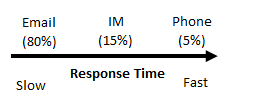Your inbox is full. You’ve received 40 text messages so far today, and it’s only noon. There’s 10 messages on your phone, just waiting for you to do something with them. Now what?
Choosing the right communication channels
When I’m collaborating virtually on work, it makes sense to have some sort of strategy on what channel we use, and when to use it. A rough guide so-to-speak. It adds some routine and flow to our collaboration.
Suppose you and your cohorts on a virtual project use 3 main channels; e.g., email, IM (internet messaging), and phone/video. When should you use each? Software company 37 Signals‘ virtual work teams use a basic formula (outlined in Remote: Office Not Required) that looks something like this:

In my project work, asynchronous communications is usually the norm. Email works fine. I/you don’t usually need an answer “now”. As long as we have a shared expectation when the reply will happen; e.g., within 24 hours, we’re good to go.
Need something a bit quicker? I’ll text you (or IM, if we’re both online). With most everyone carrying a mobile phone, text has become a preferred mode of communication for many.
Can’t wait? “We need to talk about this.” An audio connection is what we need.
The exact ratios aren’t as important as the group’s expectations. We’ll sync channel with need. And, context changes everything; e.g., in mediation, I’m heavy on the audio/phone channel.
And, of course, channel and content are 2 different things. As a facilitator of effective communications, you know that both the “medium is the message” and clear messaging (e.g., in emails) are important.
Progression of Communication
1. Email 2. IM 3. Phone = an example of progressive use, based on need, of communicaion channels.
The term “progression of communication” I came across in this interview of Sheila Jordan, SVP of Collaboration and Communication IT with Cisco Systems.
Progressive use of communication channels, in our virtual work, together, makes for a smoother collaboration.
Pick a context. What does your “progression of communication” look like?

Speak Your Mind